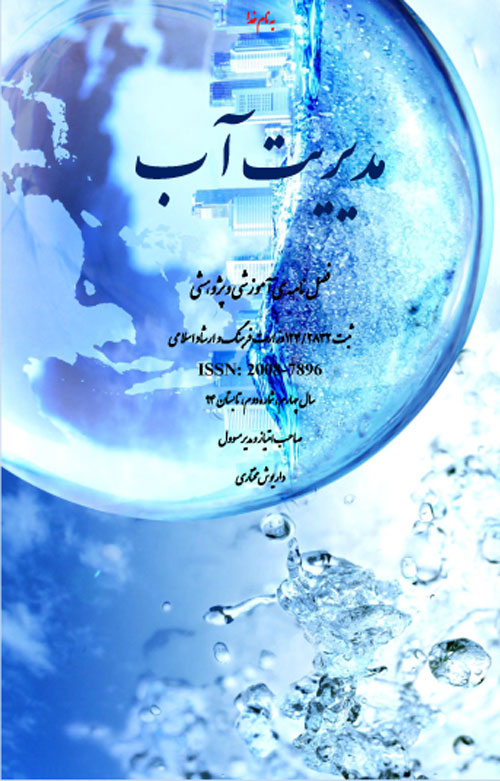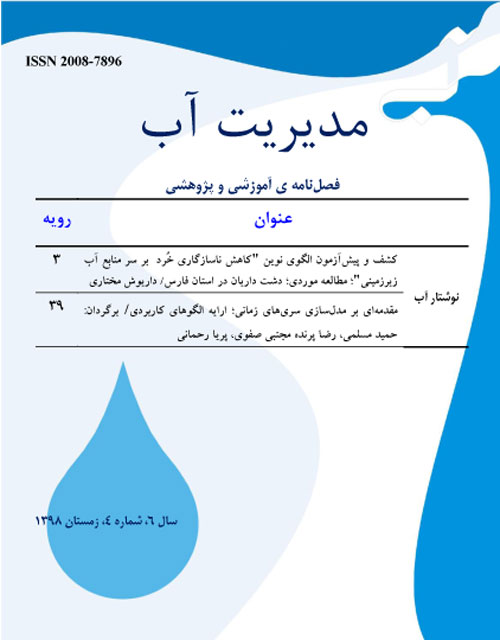فهرست مطالب

نشریه مدیریت آب
سال چهارم شماره 2 (پیاپی 9، تابستان 1394)
- بهای روی جلد: 120,000ريال
- تاریخ انتشار: 1394/06/18
- تعداد عناوین: 3
- گام های اجرایی نو (نرم افزاری) در مدیریت آب
- یادداشت آب
- نوشتار آب
-
Page 3The suggestion for the establishment of the Water Supreme court is a way to oppose the growing conflicts over water resources. Water transfer from Karoon, Dez and Zayandehrood, Development of water resources along the Karoon River, Traditional appropraitive rights of Korbal Plain (Bakhtegan basin-Fars Province), Environmental repairian rights of Lakes and Wetlands and Rivers, Disagreement over refined waste water from the city of Shiraz and small and regional cases are among the complex cases that a court branch can not handle. The problem is not just in legal and judicial procedures, but also in need of a judicial authority that have to be also the weight of the water crisis. The object of the weighth is that having the "authority" attributes for an independent institution and judicial authority (in the context of the judicial system) is necessary to respond to provincial complaints and disgruntled complainants. If such a court is not formed, there will not be any possibility of confrontation with conflicts. In this suggestion, the Judiciary system will set up the Supreme Court for water.Regarding the court order, there are a wide range of issues, such as the type of court (one or two degrees), the jury, the arbitration panel, the procedure, the composition of the judges, the technical commissions and the official experts of the judiciary. Which is worthy of the views expressed in this article (the participation of the state and local communities in resolving claims for water resources) would be adopted.Keywords: Water Supreme Court, Participation, Government, Local Communities, Farmers
-
Page 37Water problems in the country,s Iran can be divided into two groups of problems due to natural characteristics and problems caused by wicked management. For water planning, two types of use have to be defined: first, the annual consumption of the country in urban and rural areas (home-green space), agriculture and industry. Second, the environmental contribution. Because of lack of planning, the country's consumption and circulation of water in different sectors of household, agriculture and industry is much higher than the world average. The disadvantages are so much that most people and decision-makers in different categories still do not believe in critical situations. One of the other problems is the low price of water in Iran compared to other countries. Another problem is the lack of awareness among water consumers. One of the basic steps to be taken is to provide timely, real, and non-conscientious information on the long-term and permanent planning of the state of the water to the public.Keywords: water resources management, planning, geographic location, water status
-
Page 45In the present study, firstly, the data of observation wells of years (1991-2011), the water crisis in the Jaghine and Toukour Plain in Hormozgan province were investigated and presented by the unit hydrograph. The results of the water level in 30 observation wells indicate that the average groundwater drop in the Jaghine and Toukour basins for the study period was 16.8 meters. The aquifer has a tank fraction of 93 million cubic meters. One of the most important factors of declining to water level in Jaghine and Toukour aquifer are: drought, over withdrawal, population increase, increased cropping area and a large number of wells. The prediction results indicate that if the current conditions be continued and the absence of serious actions, in the next 10 years, the groundwater level of this aquifer will fall by more than 4.2 meters. With solutions such as not issuing new drilling licenses, protecting aquifers and artificial feeding, building an underground dam, providing optimal cultivation patterns, using new irrigation methods, along with controlling the amount of water pumping and cropping and water pricing in the agricultural sector can be Reduced the amount of groundwater and its consequences.Keywords: Aquifer, Jaghine, Toukour, Water crisis, Development, Population, Agriculture, Management


